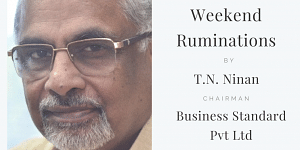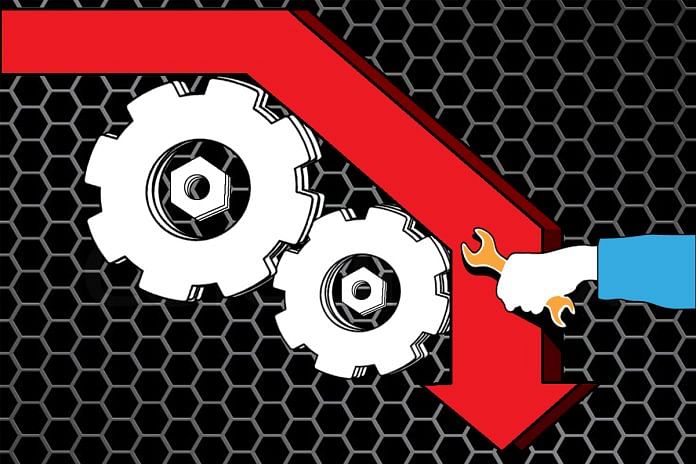If the Modi government hopes to accelerate India’s growth rate, and create more jobs and boost fiscal revenues, it will have to make a success of manufacturing.
Jobs in manufacturing don’t matter! That, in substance, was what the International Monetary Fund (IMF) said last month, in its latest World Economic Outlook. To quote from its summary: “A shift in employment from manufacturing to services need not hinder economy-wide productivity growth and the prospects for developing economies to gain ground toward advanced-economy income levels.” The report made the headlines in India, and presumably in other countries.
But India has already demonstrated the truth of the first part of that statement: We have been improving productivity despite failure to build a strong manufacturing base. Indeed, employment in manufacturing is only 8 per cent of the total, or less. So, in truth, what’s the news in this?
The IMF misses the point. First, how much more would labour productivity improve if workers in India moved from agriculture (plagued by under-employment) to manufacturing? Second, manufacturing is not important merely from the employment angle. Every leading power on earth happens to also be a manufacturing power. China is the world’s leading manufacturer, Germany occupies that position in Europe, Japan and South Korea rose to global prominence through manufacturing, and so on. Despite an abundance of natural resources, two of the Brics countries have stopped short of making the grade because they failed in manufacturing. In Russia manufacturing contributes only 14 per cent of gross domestic product (GDP), and in Brazil 12 per cent. India’s figure is 17 per cent. Historically, no country has made the grade with manufacturing accounting for less than 20 per cent of GDP. All the countries of East Asia qualify on that metric.
 It is possible that history is about to be rewritten because of the fourth industrial revolution (encompassing new technologies like 3D printing and artificial intelligence, and the fusion of manufacturing and services). There is also Apple: It pays its manufacturing suppliers in Asia a small fraction of the retail price of its wannahaves, thereby pocketing a stupendous 30 per cent profit margin. But it is dangerous for middle-income countries to set national strategies on the basis of companies like Apple.
It is possible that history is about to be rewritten because of the fourth industrial revolution (encompassing new technologies like 3D printing and artificial intelligence, and the fusion of manufacturing and services). There is also Apple: It pays its manufacturing suppliers in Asia a small fraction of the retail price of its wannahaves, thereby pocketing a stupendous 30 per cent profit margin. But it is dangerous for middle-income countries to set national strategies on the basis of companies like Apple.
Why? Because a manufacturing base usually has more backward and forward linkages than services — which is why an industrial centre sparks all-round development in its area. It contributes to the tax base, while strength in manufacturing also translates into a strong export base: Thailand has 27 per cent of its GDP coming from manufacturing, but more than three-quarters of its exports. And it has a trade surplus, unlike India. The Thai baht, measured against the rupee, has doubled in value since 1991 — an indication of how much faster productivity has improved in that country.
Without a civilian manufacturing base (everything from shipbuilding to high-end engineering and electronics), India will remain the world’s largest importer of defence equipment. The development of new technologies and products depends on local production units that innovate and move up the value chain — as Krupps once showed in Germany by moving from steel to armaments, a journey that Bharat Forge is now traversing. Similarly, the natural progression from steelmaking to shipbuilding (achieved at various stages by Japan, Korea and China, and before that by Britain and others) is yet to happen in India. The navy’s ships under construction had to wait for years for the right kind of steel. Military technology, vital for national security, does not flourish in an industrial wasteland.
That is why it is tragic that the share of manufacturing in India’s GDP has remained virtually unchanged, despite Make in India and its predecessor, the UPA’s New Manufacturing Policy. If the Modi government hopes to accelerate the economy’s growth rate from the 7+ per cent of the last decade to 8 per cent and more, and to get rid of its large and growing deficit in merchandise trade, and along the way to create more jobs and boost fiscal revenues, it will have to forget the IMF and make a success of manufacturing. As it celebrates its four years in office, it should re-examine why this has not happened so far.
By special arrangement with Business Standard
पढ़ें हिंदी में: मैन्युफैक्चरिंग सुधारे बिना भारत को बड़ी शक्ति के रूप में देखना आईएमएफ की बड़ी भूल






